 W
WThe rules of baseball differ slightly from league to league, but in general share the same basic game play.
 W
WIn baseball, a pitcher can commit a number of illegal motions or actions that constitute a balk. Most of these violations involve a pitcher pretending to pitch when he has no intention of doing so. In games played under the Official Baseball Rules that govern professional play in the United States and Canada, a balk results in a dead ball or delayed dead ball. In certain other circumstances, a balk may be wholly or partially disregarded. Under other rule sets, notably in the United States under the National Federation of High Schools Baseball Rules, a balk results in an immediate dead ball. In the event a balk is enforced, the pitch is generally nullified, each runner is awarded one base, and the batter (generally) remains at bat, and with the previous count. The balk rule in Major League Baseball was introduced in 1898.
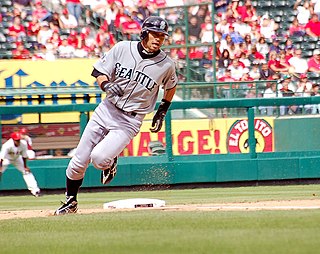 W
WIn baseball, base running is the act of running from base to base, performed by members of the team at bat.
 W
WA baseball field, also called a ball field, sandlot or a baseball diamond, is the field upon which the game of baseball is played. The term can also be used as a metonym for a baseball park.
 W
WA bunt is a batting technique in baseball or fastpitch softball. To bunt, the batter loosely holds the bat in front of home plate and intentionally taps the ball into play. A properly executed bunt will create weak contact with the ball and/or strategically direct it, forcing the infielders to make a difficult defensive play to record an out.
 W
WIn baseball, the designated hitter (DH) is a player that bats in place of the pitcher. The position is authorized by Major League Baseball Rule 5.11, and was adopted by the American League in 1973. Since then, almost all amateur, collegiate, and professional leagues have adopted the rule or some variant with the notable exception of MLB's National League and Nippon Professional Baseball's Central League.
 W
WExtra innings is the extension of a baseball or softball game in order to break a tie.
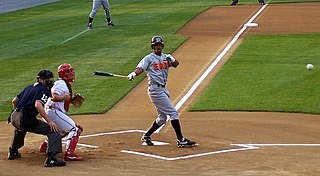 W
WIn baseball, a foul ball is a batted ball that:Settles on foul territory between home and first base or between home and third base, or Bounds past first or third base on or over foul territory, or First falls on foul territory beyond first or third base, or While on or over foul territory, touches the person of an umpire or player, or any object foreign to the natural ground. By interpretation, a batted ball that touches a batter while in his batter's box is foul regardless of whether it is over foul territory.
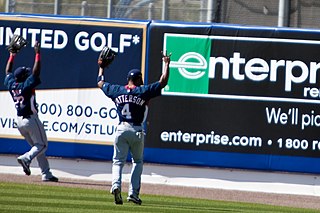 W
WA ground rule double is a baseball rule that awards two bases from the time of pitch to all baserunners including the batter-runner, as a result of the ball leaving play after being hit fairly and leaving the field under a condition of the ground rules in effect at the field where the game is being played. An automatic double is the term used to refer to a fairly hit ball leaving the field in circumstances that do not merit a home run. The automatic double is quite often mistakenly called a ground rule double.
 W
WIn baseball, ground rules are special rules particular to each baseball park (grounds) in which the game is played. Unlike the well-defined playing field of most other sports, the playing area of a baseball field extends to an outfield fence in fair territory and the stadium seating in foul territory. The unique design of each ballpark, including fences, dugouts, bullpens, railings, stadium domes, photographer's wells and TV camera booths, requires that rules be defined to handle situations in which these objects may interact or interfere with the ball in play or with the players.
 W
WIn baseball statistics, a hit, also called a base hit, is credited to a batter when the batter safely reaches or passes first base after hitting the ball into fair territory, without the benefit of an error or a fielder's choice.
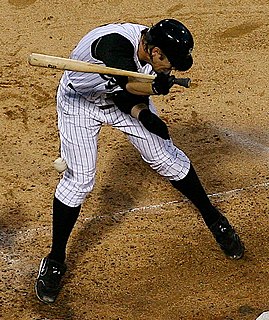 W
WIn baseball, hit by pitch (HBP) is an event in which a batter or his clothing or equipment is struck directly by a pitch from the pitcher; the batter is called a hit batsman (HB). A hit batsman is awarded first base, provided that he made an honest effort to avoid the pitch, although failure to do so is rarely called by an umpire. Being hit by a pitch is often caused by a batter standing too close to, or "crowding", home plate.
 W
WIn baseball, a home run is scored when the ball is hit in such a way that the batter is able to circle the bases and reach home safely in one play without any errors being committed by the defensive team in the process. In modern baseball, the feat is typically achieved by hitting the ball over the outfield fence between the foul poles without first touching the ground, resulting in an automatic home run. There is also the "inside-the-park" home run where the batter reaches home safely while the baseball is in play on the field.
 W
WIn baseball, the rules state that a batted ball is considered in flight when it has not yet touched any object other than a fielder or his equipment.
 W
WThe infield fly rule is a rule of baseball that treats certain fly balls as though caught, before the ball is caught, even if the infielder fails to catch it or drops it on purpose. The umpire's declaration of an infield fly means that the batter is out regardless of whether the ball is caught. The rule exists solely to prevent the defense from executing a double play or triple play by deliberately failing to catch a ball that an infielder could catch with ordinary effort.
 W
WIn baseball, softball, and similar games, an inning is the basic unit of play, consisting of two halves or frames, the "top" and the "bottom". In each half, one team bats until three outs are made, with the other team playing defense. A full baseball game is typically scheduled for nine innings, while softball games consist of seven innings; although this may be shortened due to weather or extended if the score is tied at the end of the scheduled innings. The use of the term inning in baseball and softball contrasts with cricket and rounders, in which the term is innings in both singular and plural.
 W
WMajor League Baseball (MLB) allows the instant replay review to allow league officials to review certain types of plays in order to determine the accuracy of the initial call of the umpires on the field. Reviews may be initiated either by a team's manager with limitations or by the umpires themselves. All instant-replay reviews are examined by umpires at the Replay Command Center in New York City, who has the final decision as to whether to uphold or overturn the initial call.
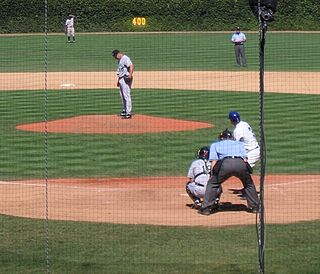 W
WIn baseball, when the ball is alive, the game can proceed. The pitcher may pitch the ball, the batter may attempt to hit such a pitch, baserunners may attempt to advance at their own risk, and the defense may attempt to put the batter or baserunners out.
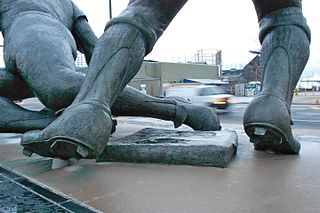 W
WIn baseball, a neighborhood play is a force play in which a fielder receiving the ball in attempting to force out a runner at second base, catches and quickly throws the ball to first base in a double play attempt without actually touching second base, or by touching second base well before catching the ball. By every rules code, such a play is not an out, because to record a force out, the fielder with the ball must actually touch a force base before the forced runner arrives.
 W
WIn baseball, an out occurs when the umpire rules a batter or baserunner out for one of the reasons given below. When a player is out, they leave the field and can no longer score. When three outs are recorded in an inning, a team's half of the inning, ends.
 W
WA pitch clock is used in college baseball and Minor League Baseball to limit the amount of time a pitcher uses before he throws the ball to the hitter. This is one measure that has accelerated the pace of play.
 W
WIn baseball, a run is scored when a player advances around first, second and third base and returns safely to home plate, touching the bases in that order, before three outs are recorded and all obligations to reach base safely on batted balls are met or assured. A player may score by hitting a home run or by any combination of plays that puts him safely "on base" as a runner and subsequently brings him home. The object of the game is for a team to score more runs than its opponent.
 W
WA rundown, informally known as a pickle or the hotbox, is a situation in the game of baseball that occurs when the baserunner is stranded between two bases, also known as no-man's land, and is in jeopardy of being tagged out. When the base runner attempts to advance to the next base, he is cut off by the defensive player who has a live ball and attempts to return to his previous base before being tagged out. As he is doing this, the defenseman throws the ball past the base runner to the previous base, forcing him to reverse directions again. This is repeated until the runner is put out or reaches a base safely.
 W
WIn baseball, a baserunner is safe when he reaches a base without being put out by various ways. While a runner is touching a base, he is usually not in jeopardy of being put out, and is thus "safe" from fielders' actions. The runner is in jeopardy once again, negating this safety, when he ceases touching the base, when forced on a force play, or when the runner commits interference.
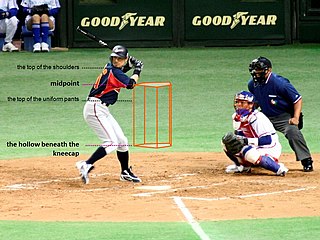 W
WIn baseball, the strike zone is the volume of space through which a pitch must pass in order to be called a strike even if the batter does not swing. The strike zone is defined as the volume of space above home plate and between the batter's knees and the midpoint of their torso. Whether a pitch passes through the zone is decided by an umpire, who is generally positioned behind the catcher.
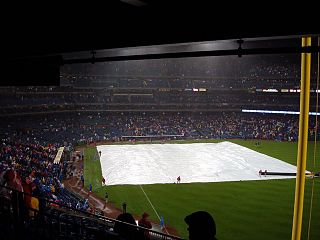 W
WA suspended game in baseball occurs when a game has to be stopped before it can be completed, and the game is meant to be finished at a later time or date. Suspended games are used in Major League Baseball, Minor League Baseball, and may also be used at other levels of play depending on league or tournament rules.
 W
WIn baseball, a tag out, sometimes just called a tag, is a play in which a baserunner is out because a fielder touches him with the ball or with the hand or glove holding the ball, while the ball is live and the runner is in jeopardy of being put out – usually when he is not touching a base.
 W
WTie goes to the runner is a popular interpretation of baseball rules. The claim is that a batter-runner who arrives on base the same time as the ball is safe. However, umpires generally reject the concept that baseball provides for a tie in this way, and instead rule on the basis that either the player or the ball has reached the base first.
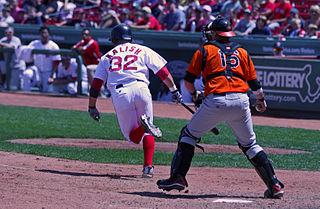 W
WIn baseball and softball, an uncaught third strike occurs when the catcher fails to cleanly catch a pitch for the third strike of a plate appearance. In Major League Baseball (MLB), the specific rules concerning the uncaught third strike are addressed in Rules 5.05 and 5.09 of the Official Baseball Rules: This is one of the oldest rules in modern baseball, dating at least to the Knickerbocker Rules of 1845: "Three balls being struck at and missed and the last one caught, is a hand-out."
 W
WThe unwritten rules of baseball are a set of unspoken rules in baseball that some players and managers follow. The rules often concern gamesmanship and not disrespecting players on the opposing team. Incidents have occurred when one or more players interpret the actions of another player as violating the unwritten rules, which can result in beanballs and bench-clearing brawls. As the rules are unwritten, and in many cases vague, the interpretation is left to the players involved.